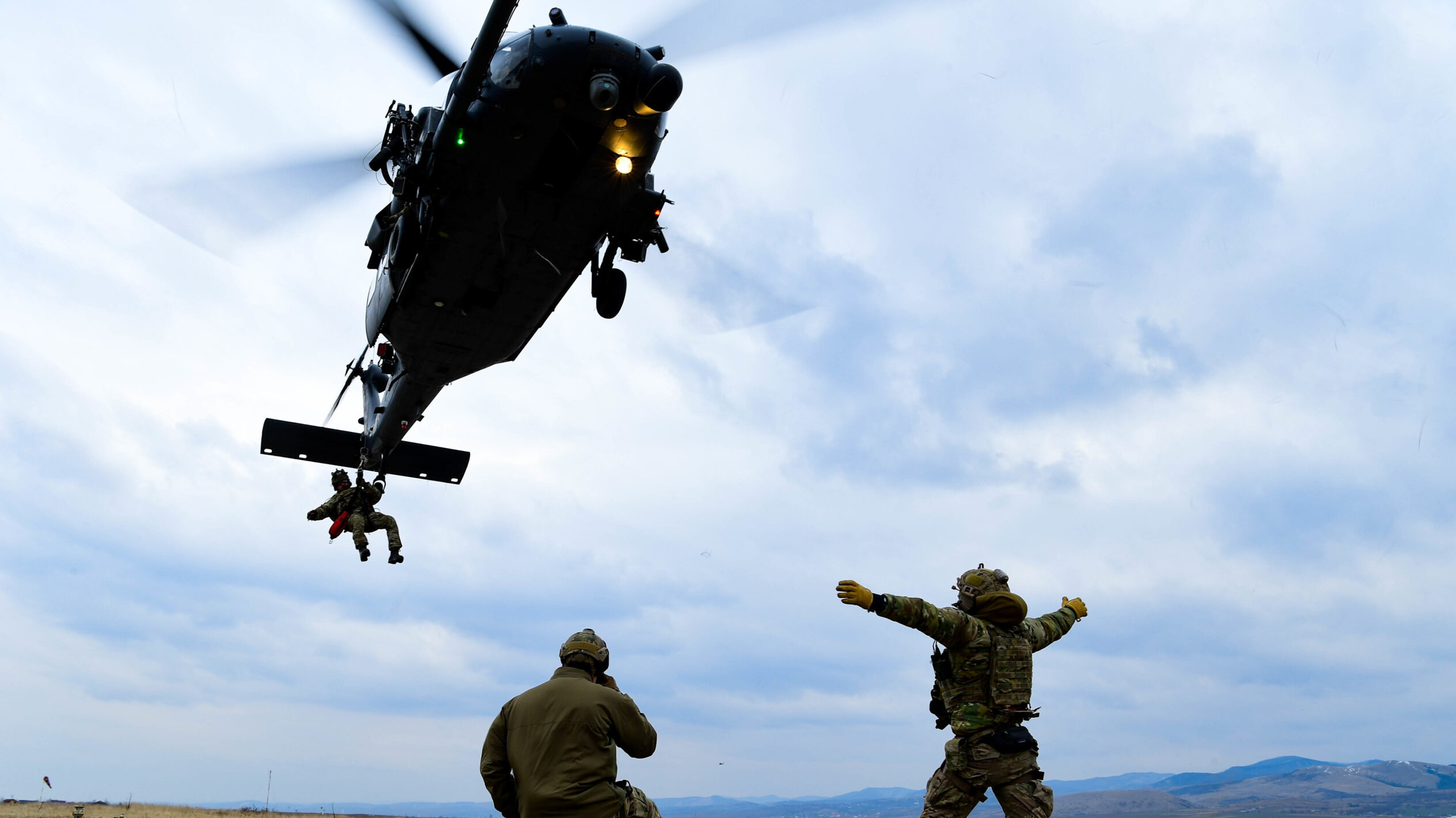
House lawmakers in their annual policy legislation moved to force the creation of a low-yield nuclear cruise missile that would be fired from US Navy submarines. (US Navy)
WASHINGTON — The House Armed Services Committee overnight advanced its annual defense policy bill with an overwhelmingly bipartisan vote that includes several potential major Pentagon policy shifts, such as the establishment of a program of record for a low-yield nuclear cruise missile.
The final vote of 58-1 took place in the early hours of today, following lengthy debates about social issues ranging from critical race theory to drag shows on military installations. Rep. Ro Khanna, D-Calif., was the only lawmaker to vote in the negative. The bill recommends an $874.2 billion defense budget for fiscal year 2024, which aligns with the budget deal the White House made with congressional leaders in May. (Although the Fiscal Responsibility Act of 2023 approved a defense spending cap of $886 billion, the House Armed Services Committee lacks the jurisdiction to approve roughly $12 billion in funding controlled by other committees.)
While the bill’s passage out of committee is a significant step towards the president’s desk, the legislation — and all of its provisions — must now survive a debate on the House floor as well as reconciliation with the Senate’s counterpart bill before being signed into law.
Separately, the Senate Armed Services Committee, House Appropriations Committee and the Senate Appropriations Committees are all advancing their own pieces of defense legislation this week which are expected to be completed or unveiled in the coming weeks.
That’s a wrap on House Armed Services Committe’s markup of the #FY24NDAA. The committee approves the bill in a 58-1 blowout.
(Dem Ro Khanna is the only member voting against the bill.) pic.twitter.com/YLD9Mmn8B0
— Connor O'Brien (@connorobrienNH) June 22, 2023
New House, New Life For A New Nuclear Weapon
With the House now in GOP control for the first time since 2018, Republicans, led by Colorado Rep. Doug Lamborn were able to approve a provision that directs the Pentagon to establish a program of record for a low-yield nuclear cruise missile. Experimentation for such a weapon has effectively been on life support since the White House last year expressed opposition to its development, citing fears it would increase the possibility of nuclear-armed conflict.
Advocates of the weapon, called SLCM-N, say America’s adversaries will develop similar munitions regardless of the White House’s policy concerns and the United States must be prepared. Those advocates include the country’s top military officer, Chairman of the Joint Chiefs of Staff Army Gen. Mark Milley, who has told lawmakers the weapon, despite the administration’s opposition, provides “options” in case of an emergency situation.
“I will say that to you though, as members of Congress who have oversight responsibilities, my position on SLCM-N has not changed,” Milley said in April 2022. “My general view is that this president or any president deserves to have multiple options to deal with national security situations.”
Rep. Joe Courtney, D-Conn., attempted to modify Lamborn’s amendment with language that would allow the Pentagon to scrap the SLCM-N program of record if the Navy, which would be the weapon’s primary user, found integrating it would harm the submarine fleet’s ability to conduct “conventional missions.” The committee voted down Courtney’s perfecting amendment.
Ships, Helos, Munitions: The Bread and Butter of The Defense Bill
The committee on a bipartisan basis approved a provision that would assist the Navy in paying for an additional San Antonio-class amphibious transport dock. While congressional authorizers have shown overwhelming support for that ship, which the White House did not request, House appropriators have thus far not included it in their defense spending bill, meaning it’s not yet clear whether the Pentagon will ultimately begin buying the ship next year.
RELATED: Navy’s Del Toro balks at lawmakers’ shipbuilding plan demand, will ‘meet’ amphib needs

Pararescuemen assigned to the 57th Rescue Squadron perform dynamic hoist training with an HH-60G Pave Hawk in Romania. (U.S. Air Force photo by Senior Airman Noah Sudolcan)
The committee approved a provision that would prevent the Air Force from using money to shut down, or prepare to shut down, Sikorsky’s HH-60 production line. As part of its fiscal 2024 budget request, the service wanted to stick to plans it established last year to end procurement of the helicopter, dropping an original program of record from 113 to 75.
At the same time, though, the Army’s selection of the Bell’s V-280 Valor for its multi-billion-dollar Future Long-Range Assault Aircraft (FLRAA) program, places more focus on Sikorsky’s helo production as Army leaders now have a clear vision of what will replace a sizable number of Sikorsky UH-60 Black Hawks. However, they must also grapple with UH-60 sustainment plans and the as of yet undetermined mix of FLRAA and Black Hawks to fly in the future.
House defense authorizers this week also noted concerns about reductions in T-38 Talon sorties due to a lack of serviceable General Electric J85 turbojet engines. To better understand the issue, the committee approved a provision requiring the Air Force secretary to provide an overview of the T-38 fleet, including airworthiness and readiness rates, the strategic maintenance plan for the T-38, impacts of the T-7 program’s delays on the lifespan of the T-38 fleet, and other issues.
House lawmakers would also seek to keep the Adaptive Engine Transition Program going, after the Air Force indicated it was ditching the program for the F-35, with $588 million in authorized funds — a significantly greater amount than what House appropriators would back, based on the $150 million they offered to keep the program alive. (The HASC would also fully fund the engine core upgrade, the Pentagon’s preferred approach for modernizing the F-35’s engine.) Those legislative moves come just as engine-maker Pratt & Whitney entered into a high-profile spat with airframe maker Lockheed Martin over the engines’ future.
RELATED: Pratt blasts Lockheed’s ‘confusing and misleading’ adaptive engine advocacy (Exclusive)
Elsewhere for the Army, the full committee cited concerns about the service’s prepositioned stockpiles (APS) and, if a provision is ultimately signed into law, the service secretary is tasked with crafting a plan to improve inspections. Although the committee did not cite its specific concerns about APS, the Pentagon’s inspector general has released several damning reports about poorly maintained equipment from those stockpiles including some sent to Ukraine, and a separate report released on Tuesday digging into the problems of one particular stockpile, APS-5 in Kuwait, that could impact readiness.
Innovation Front
Looking further into the future, House lawmakers want to create a new “nontraditional innovation fielding enterprise” (NIFE) in the Pentagon’s Defense Innovation Unit (DIU) to “streamline coordination and minimize duplication of efforts among elements of the Department of Defense on matters relating to the development, procurement, and fielding of nontraditional capabilities.”
NIFE would be led by the director of DIU, Doug Beck, and designated leads from each military service, according to an amendment introduced by Rep. Mike Gallagher, R-Wisc. DIU would coordinate with the Joint Staff and combatant commanders to “identify operational challenges that have the potential to be addressed through the use of nontraditional capabilities, including dual-use technologies, that are being developed and financed in the commercial sector.”
Beck would also serve as the chair of the NIFE Resource Advisory Board, which would include each service-level lead, the director of the Joint Staff, the Chief Digital and Artificial Intelligence Officer and the director of the Office of Strategic Capital, according to the amendment. The board would meet on an annual basis to identify 10 objectives that can be supported through NIFE and fielded within three years.
In April, the Defense Department announced that DIU will now report to the secretary of defense rather than the undersecretary of defense for research and engineering (USD(R&E)). Beck was also tasked with providing the secretary of defense an assessment of its capabilities and what milestones DIU plans to hit.
House lawmakers on the cyber, information technology and innovation (CITI) subcommittee in June also proposed expanding the USD(R&E)’s role to include more oversight of commercial technologies for defense under a new role and title: undersecretary of defense for technology integration and innovation.
Now, lawmakers want the Pentagon’s comptroller to review the functions of the USD(R&E), saying the committee is concerned the office “has neither fully nor sufficiently executed the authorities granted to it under statute and in policy for managing, overseeing, and improving innovation-related investments across DOD.” According to an amendment introduced by Rep. Rob Wittman (R-Va.), progress in innovation is lagging in key defense technology areas.
“The committee is also concerned the Department of Defense may be missing opportunities to fully collaborate science and technology efforts within and across all components for maximum efficiency and effectiveness,” according to the amendment. “The mix of investments that military components and defense agencies make in disruptive and incremental technology development remains unknown and unassessed.”
The amendment also says that “new technologies continue to get bogged down in long, linear development structured defense acquisition programs that delay their delivery to the warfighters who need them.”
The comptroller is tasked with recommending policies and statutory changes for the USD(R&E).
The formal vote on the committee’s markup comes the same day as the other three committees overseeing the Pentagon — the Senate Armed Services Committee and House and Senate Appropriations Committees — continue marking up their own respective annual defense bills — all lengthy, but necessary steps before the bills can reach President Joe Biden’s desk for a final signature.
Michael Marrow contributed to this report.








